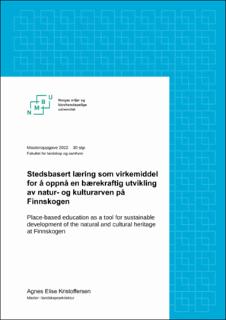| dc.contributor.advisor | Bergaust, Tore Edvard | |
| dc.contributor.advisor | Clemetsen, Morten | |
| dc.contributor.author | Kristoffersen, Agnes Elise Monsen | |
| dc.coverage.spatial | Norway, Hedmark, FInnskogen | en_US |
| dc.date.accessioned | 2022-12-13T09:41:06Z | |
| dc.date.available | 2022-12-13T09:41:06Z | |
| dc.date.issued | 2022 | |
| dc.identifier.uri | https://hdl.handle.net/11250/3037423 | |
| dc.description.abstract | The landscape around us tells the story of where we live. Changes in the landscapes
happens quickly and conservation and good management are important so that the
our history does not disappear. There are important and useful values in cultural
heritage. In order to achieve a future that is sustainable, we must take care of these
through well-developed management. A part of the history found in natural and
cultural heritage is difficult to preserve. Text and literature will not be able to teach an
experience or place-specific traditions as easily.
With my thesis, I want to find out how natural and cultural heritage can be preserved
and further developed in a sustainable way. As a method for achieving sustainable
development and conservation at Finnskogen, I use the method of place-based
learning. This method approaches the management of natural resources by including
children and young people through learning. Location-based learning is the main
subject of my thesis, and my choices of theory and stakeholders is done based on
this. Learning and education are important in relation to natural and cultural heritage
in my thesis, and I have chosen to put the spotlight on place-based learning in
school. Identity and belonging are also important topics.
To form an overview of Finnskogen's qualities, opportunities, and challenges, I use a
landscape analysis of the area. As a basis for the feasibility study, I use theory that
deals with relevant topics: landscape, identity, and democracy. This provides a guide
for how the resources at Finnskogen should be prioritized in the analysis and how
measures should be implemented. Different methods in the work of collecting data
are used to provide a starting point that includes several angles and perspectives. In
the discussion section, problems and advantages at Finnskogen and Abborhøgda as
a place for place-based learning are mentioned, and it is finally concluded that it will
contribute to positive effects for the natural and cultural heritage even if you will meet
some challenges along the way. | en_US |
| dc.description.abstract | The landscape around us tells the story of where we live. Changes in the landscapes happens quickly and conservation and good management are important so that the our history does not disappear. There are important and useful values in cultural heritage. In order to achieve a future that is sustainable, we must take care of these through well-developed management. A part of the history found in natural and cultural heritage is difficult to preserve. Text and literature will not be able to teach an experience or place-specific traditions as easily.
With my thesis, I want to find out how natural and cultural heritage can be preserved and further developed in a sustainable way. As a method for achieving sustainable development and conservation at Finnskogen, I use the method of place-based learning. This method approaches the management of natural resources by including children and young people through learning. Location-based learning is the main subject of my thesis, and my choices of theory and stakeholders is done based on this. Learning and education are important in relation to natural and cultural heritage in my thesis, and I have chosen to put the spotlight on place-based learning in school. Identity and belonging are also important topics.
To form an overview of Finnskogen's qualities, opportunities, and challenges, I use a landscape analysis of the area. As a basis for the feasibility study, I use theory that deals with relevant topics: landscape, identity, and democracy. This provides a guide for how the resources at Finnskogen should be prioritized in the analysis and how measures should be implemented. Different methods in the work of collecting data are used to provide a starting point that includes several angles and perspectives. In the discussion section, problems and advantages at Finnskogen and Abborhøgda as a place for place-based learning are mentioned, and it is finally concluded that it will contribute to positive effects for the natural and cultural heritage even if you will meet some challenges along the way. | en_US |
| dc.language.iso | nob | en_US |
| dc.publisher | Norwegian University Of Life Sciences, Ås | en_US |
| dc.rights | Attribution-NonCommercial-NoDerivatives 4.0 Internasjonal | * |
| dc.rights.uri | http://creativecommons.org/licenses/by-nc-nd/4.0/deed.no | * |
| dc.subject | Kulturminner | en_US |
| dc.subject | Stedsbasert læring | en_US |
| dc.subject | Cultural heritage | en_US |
| dc.title | Stedsbasert læring som virkemiddel for å oppnå en bærekraftig utvikling av natur- og kulturarven på Finnskogen | en_US |
| dc.title.alternative | Place-based education as a tool for sustainable development of the natural and cultural heritage at Finnskogen | en_US |
| dc.type | Master thesis | en_US |
| dc.source.pagenumber | 84 | en_US |
| dc.description.localcode | M-LA | en_US |

